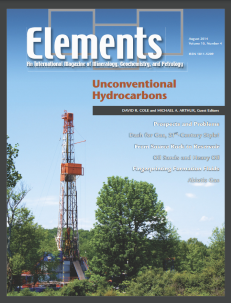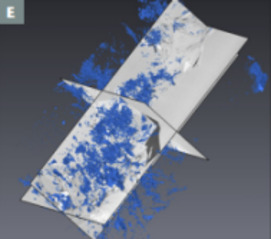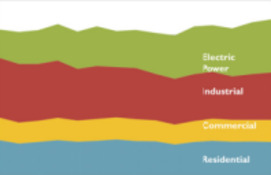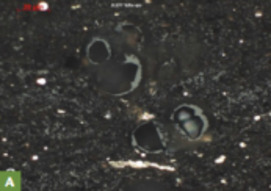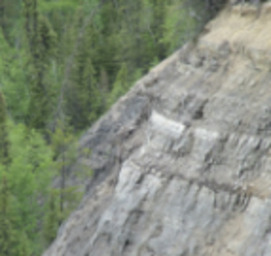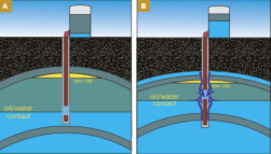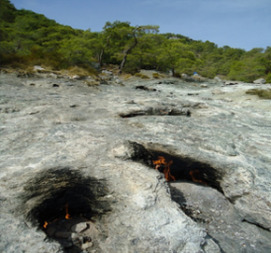
Unconventional Hydrocarbons
David R. Cole and Michael A. Arthur – Guest Editors
Table of Contents
The realization that unconventional hydrocarbons, such as gas and oil shale, oil sands, and heavy oil, can now be exploited more effec- tively and economically has stimulated exploration and exploitation on a global scale. This has led to a new economic and environmental landscape in energy matters that we are only now starting to under- stand. Exploiting unconventional hydrocarbons requires additional technology, energy, and capital compared to the industry standard. This thematic issue will address the geologic and geochemical nature of these resources and their impact on global socioeconomics and the environment.
- Unconventional Hydrocarbon Resources: Prospects and Problems
- Dash for Gas, 21st-Century Style!
- From Source Rock to Reservoir: The Evolution of Self-Sourced Unconventional Resource Plays
- Oil Sands and Heavy Oil: Origin and Exploitation
- Fingerprinting “Stray” Formation Fluids Associated with Hydrocarbon Exploration and Production
- Abiotic Gas: Atypical, But Not Rare
AHF Analysentechnik
Australian Scientific Instruments (ASI)
Bruker Nano
Cambridge University Press
Cameca
Elementa
FEI
Excalibur Mineral Corporation
Geochemist’s Workbench
Horiba
JEOL
Rigaku
Savillex
Tescan Orsay Holding
Zeiss
Thermo
v10n5 COSMOGENIC NUCLIDES: EARTH’S SURFACE CLOCK
Guest Editors: Friedhelm von Blanckenburg (GFZ Potsdam) and Jane Willenbring (University of Pennsylvania)
The Earth’s surface is the thin, ever-changing layer on which we live. The geochemical study of cosmogenic nuclides is currently revolution- izing our understanding of the processes that shape this surface layer by providing their rates and dates. The underlying physical principles are simple and elegant: when rock or soil moves into the shallow zone of surface irradiation, cosmic rays interact with elements in minerals to produce very rare isotopes—the radioactive nuclides 10 Be, 14 C, 26 Al, 36 Cl, and 53 Mn and the rare gases 3 He and 21 Ne. At this exact moment, the nuclide clock begins to tick. These nuclides can reveal the times when a river cuts down through a mountain range, when a glacial moraine was deposited, or when a river or marine terrace was aban- doned. Cosmogenic nuclides also serve to measure erosion rates directly: the longer a soil resides at the surface before being eroded, the more nuclides accumulate. Hence, these nuclides provide rates of erosion, from the scale of a pebble to as large as an entire river basin.
- Cosmogenic Nuclides: Dates and Rates of Earth-Surface Change Friedhelm von Blanckenburg (GFZ German Research Centre for Geosciences) and Jane K. Willenbring (Scripps Institution of Oceanography, University of California San Diego)
- The Nuts and Bolts of Cosmogenic Nuclide Production Tibor J. Dunai (University of Cologne) and Nathaniel A. Lifton (Purdue University)
- Dating Disappearing Ice with Cosmogenic Nuclides Susan Ivy-Ochs (ETH Zürich) and Jason P. Briner (University at Buffalo, State University of New York)
- Cosmogenic Nuclide Dating of Earthquakes, Faults, and Toppled Blocks Lucilla C. Benedetti (Cerege, Aix-en-Provence, France) and Jérôme van der Woerd (Institut de Physique du Globe de Strasbourg)
- Tracing and Pacing Soil Across Slopes Jean L. Dixon (Montana State University) and Clifford S. Riebe (University of Wyoming)
- Cosmogenic Nuclides and Erosion at the Watershed Scale Darryl E. Granger (Purdue University) and Mirjam Schaller (Universität Tübingen)
- Asteroids: Linking Meteorites and Planets (February 2014)
- Ophiolites (April 2014)
- Kaolin (June 2014)
- Unconventional Hydrocarbons (August 2014)
- Cosmogenic Nuclides (October 2014)
- Graphitic Carbon (December 2014)
Download 2015 Thematic Preview


